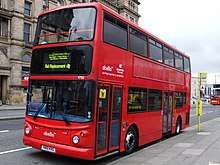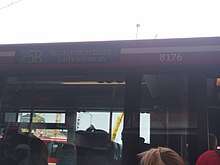Rail replacement bus service
A rail replacement bus service uses buses to replace a passenger train service either on a temporary or permanent basis. The train service that is replaced may be of any type such as light rail, tram, streetcar, commuter rail, regional rail or heavy rail, intercity passenger service. The rail service may be replaced if the line is closed due to rail maintenance, a breakdown of a train, a rail accident, strike action or to simply provide additional capacity, or if the rail service is not economically viable.

Terms for a rail replacement bus service include bustitution (a portmanteau of the words "bus" and "substitution", may also be bustitute)[1] and bus bridge.[2] Substitution of rail services by buses can be unpopular and subject to criticism, so the term bustitution is often used pejoratively.[3][4]
A similar concept in some ways is motorization, but that term more broadly refers to the rise of the automobile as well as bus transportation.
Examples
Australia
In Australia, a permanent or temporary rail-replacement service change is often referred to as bustitution.[5]
In November 1941, the Western Australian Government Railways introduced its first rail replacement service, operating a service from Perth to Kojonup via Boddington.[6] By 1949, there were 28 buses,[7] and by 1959, more than fifty.[8]
The Sydney Metro Northwest line utilised human-driven single deck buses late at night from Wednesdays to Sundays operating a red Metro bus-like service with a frequency of approximately every 10 minutes, until November 2019. This measure was in place given that the line has been deemed "ready", 10 months ahead of schedule.[9]
On the Queensland Rail network, to relieve congestion on the single track Sunshine Coast line, the rail service is supplemented by a bus service operated by Kangaroo Bus Lines on weekdays between Caboolture and Nambour as route 649.[10] NSW TrainLink, Transwa and V/Line all introduced extensive networks in New South Wales, Western Australia and Victoria in the 1970s and 1980s that replaced regional trains.
Canada
Via Rail, the operator of the national passenger rail network, uses the term "bustitution" to refer to rail replacement with buses.[1]
Ireland
As in the United Kingdom, buses replaced rail services on closed lines. The most recent example can be found in County Wexford where, upon the suspension of rail services between Rosslare Europort and Waterford in 2010, Bus Éireann route 370 was introduced. However, the bus takes considerably longer than the train journey and fails to serve Waterford railway station.[11]
Japan
Busses have been used to replace rail in Japan when rail service has to be suspended due to disaster, accident, economics, or engineering works. Notably, in some cases where those rail lines are closed permanently, some of the former rail right-of-way are converted into bus right-of-way to provide grade-separated Bus Rapid Transit service.[12]
New Zealand
When train services operated by Transdev in Auckland train services are sometimes replaced by a bus, the resulting service is called Rail Bus.[13] Historically, New Zealand Railways Road Services replaced many train routes with buses.
Sweden

While the reconstruction of Slussen, western terminal of Saltsjöbanan, is in progress, trains on line 25 only run to Henriksdal which is one station short of Slussen, with the segment between Slussen and Henriksdal served by a replacement bus 25B timed to match the train times at Henriksdal.

Also, sometimes buses can be seen running on line 7, the Spårväg City tram line even when trams are running normally.
In the night-time after 01:00, there is no service on the Stockholm Metro and the commuter rail. Therefore night busses run along the line instead.
United Kingdom
During the British Railways Board's railway rationalisation in the 1960s, known as the Beeching cuts, bus substitution was an official policy for replacing train services on closed lines. This policy was largely unsuccessful, however, as the bus services were usually far slower than the train services they replaced, causing many passengers to give up on public transport altogether.[14]
Rail replacement bus services have been used to operate Parliamentary train services.
- When North London Railways services between Watford Junction and Croxley Green were withdrawn in March 1996, to avoid the legal complications and costs of actual closure, train services were replaced by buses. The service was withdrawn when the branch was formally closed in September 2003.[15]
- Following the withdrawal of Central Trains services between Stafford and Stoke-on-Trent to facilitate the West Coast Main Line upgrade at the request of the Strategic Rail Authority in May 2003, BakerBus route X1 was introduced to serve Norton Bridge, Stone, Barlaston and Wedgwood stations.[16][17] When the train service was reintroduced by London Midland in December 2008, only Stone regained a rail service, with the other stations continuing to be served by route X1.[18][19] In October 2017, the Department for Transport declared Norton Bridge station closed, but will continue to partly fund the replacement bus service until March 2019.[20][21] As of 2019, Barlaston and Wedgwood Stations continue to be served by D&G bus replacement 14 which operates Monday to Saturday and bank holidays (not Sunday, Christmas Day, Boxing Day or New Year's Day). The Department for Transport part funds this contractual service while it seeks a "sustainable solution" to the demands for the restoration of the train service. This bustitution has existed for sixteen years as of 2019. Department for Transport decision following the 2016 Consultation and the award of the West Midlands Railway franchise in 2018.
- Following the withdrawal of services by Arriva CrossCountry between Reading and Brighton in December 2008 that were the only passenger services on three short sections of line between Ealing Broadway and Wandsworth Road, a replacement weekly bus service was introduced.[22][23] The service ceased in June 2013, after a formal closure process was completed.[24][25]
United States
Rail-replacement bus services occurred on a large scale following the dismantling of the street railway systems of many cities in North America in the mid-20th century.[26][27]
Temporary substitution of buses for trains may be done with Amtrak's Thruway Motorcoach service.[28]
The Orange Line of the Los Angeles Metro, soon to be called the F line, runs along a paved closed course on the easement from the original Southern Pacific Railroad Burbank line, later used by the Pacific Electric Railway.
Singapore
The incident that happened in Singapore on 7 July 2015 after a mass shutdown on the North South East West Lines after a power system failure. Operator SMRT and rival SBS Transit did not activate bus bridging but made all buses free islandwide due to the sheer scale of the disruptions.[29][30] The Land Transport Authority made travel free available for any bus services passing MRT stations affected during any train disruptions and in the event a massive disruption affecting at least 2 lines, bus travel islandwide would be free.[30]
Urban transit
Rail-replacement bus services are common among urban rail transit systems, mainly due to unexpected service disruptions. For example, one of the effects of Hurricane Sandy in New York was that the New York City Subway required replacement bus service for several subway routes.[31] As the subway runs 24/7/365, replacement bus service is also provided when subway lines were closed for regularly scheduled maintenance, so interruptions in subway service require replacement bus service, even during off-peak hours.
Planning rail-replacement services in a high-patronage environment, such as a high-capacity rapid transit network, requires efficient use and management of time and resources in order to prevent major travel disruptions. This was exemplified by a July 2015 shutdown on the Toronto subway during rush hour caused by a communication system breakdown, in which the local transit operator opted not to use replacement buses as "it wasn't possible to replace the entire subway's capacity with buses". [32]
.jpg)
 Canada: A TTC bus seen replacing streetcars on Dundas Street in Toronto during track maintenance on the 505 Dundas route in 2011
Canada: A TTC bus seen replacing streetcars on Dundas Street in Toronto during track maintenance on the 505 Dundas route in 2011
_meeting_FGW_150244.jpg) United Kingdom: First Devon & Cornwall rail replacement coach in Bridgwater station
United Kingdom: First Devon & Cornwall rail replacement coach in Bridgwater station United States: New York City Bus provides shuttle service in the Bronx due to construction on the New York City Subway
United States: New York City Bus provides shuttle service in the Bronx due to construction on the New York City Subway
See also
- Abandonment (legal) § Abandonment of public transportation systems
- Beeching cuts, an example of bus service replacing rail service
- Bus rapid transit
- Effects of the car on societies
- Rail trail
- Transport economics
References
- "Definition of bustitution". Macmillan Publishers Ltd.
- 'Limited MTA service backj Thursday' on New York Daily News website, viewed 2013-07-09
- An example appears in a 2009 editorial. See: Parker, Christopher (January 19, 2009). "Statement on the bustitution of the Ethan Allen Express". Vermont Rail Action Network. Archived from the original on 2011-07-27. Retrieved 2009-06-20.
- Weyrich, Paul M. and William S. Lind (May 1999). "Does Transit Work? A Conservative Reappraisal" (PDF). American Public Transportation Association. Retrieved 2016-09-07.
- "Bustitution over Xmas". Media Release – Newsletter. Action for Public Transport (New South Wales). 1993 (1). February 1993. ISSN 0155-8234. Retrieved 2009-06-22.
- Royal Commission into the Management, Workings & Control of the Western Australian Government Railways Government of Western Australia December 1947 page 92
- WAGR buses shift 360,000 in a year The Sunday Times 28 August 1949 page 3
- Annual Report for the year ended 30 June 2003 Western Australian Government Railways Commission
- "NSW Budget: $12 billion for metro rail revolution | Sydney Metro". www.sydneymetro.info. Retrieved 6 May 2019.
- Route 649 TransLink
- http://buseireann.ie/timetables/1425905570-370.pdf
- JR気仙沼線の線路跡、バス専用道一部完成 Nikkei
- "How to use a railbus". Auckland Transport, assessed 2013-07-07
- Henshaw, David (1994). The Great Railway Conspiracy. ISBN 0-948135-48-4.
- "Croxley Green LNWR Branch Passenger Closure". 'Rail Chronology
- "Stations close to trains". BBC News. 16 May 2003. Retrieved 28 September 2018.
- "Fewer buses for Barlastan". The Stone & Eccleshall Gazette. 13 November 2013. Retrieved 28 September 2018.
- New Timetable Means New Services for Stoke. Network Rail, 14 December 2008
- "Stone station is re-opened". The Railway Magazine issue 1294 (February 2009), page 64
- Summary to the responses to consultation to proposed closure of Norton Bridge Station. Department for Transport (2017)
- Closure Ratification Notice - Norton Bridge Station. Office of Rail & Road (26 October 2017)
- Swaine, Jon (7 January 2009). "Government runs 'ghost bus' to avoid admitting it scrapped rail service". The Telegraph. Retrieved 28 September 2018.
- Withdrawal of Scheduled Passenger Services Between Wandsworth Road, Kensington (Olympia) & Ealing Broadway. Office of Rail Regulation (10 May 2012)
- "'Ghost bus' makes final journey". ITV News. 11 June 2013. Retrieved 28 September 2018.
- "Last Olympia - Wandsworth Road". Today's Railways UK issue 140 (August 2013), page 19
- An example from Milwaukee, Wisconsin may be seen in a picture caption at: "Motor Coaches of The Brew City". Retrieved 2009-06-21.
- "Newark PCC 27 Arrives at the Museum". Shoreline Trolley Museum. October 14, 2001. Retrieved 2009-06-21.
- "Thruway Motorcoach Service and Accessibility". Amtrak. Retrieved 2009-06-21.
- "SMRT to be fined a record S$5.4m for July 7 MRT breakdown". Channel NewsAsia. Retrieved 2017-06-18.
- "Free bus services during extended MRT disruption". www.mot.gov.sg. Ministry of Transport, Singapore. Archived from the original on 2015-09-29. Retrieved 2017-06-18.
- "NYC DOT and MTA/NYCT to Establish Dedicated Shuttle Bus Routes Between Brooklyn and Midtown Manhattan as Storm Repairs Continue". New York City Department of Transportation (Press release). October 31, 2012.
- "Toronto subway shutdown causes early-morning commuter chaos". CBC News. Canadian Broadcasting Corporation. June 8, 2015. Retrieved October 15, 2016.
External links

